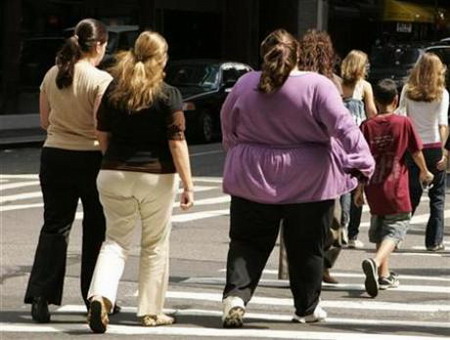Science and Health
US obesity rate appears to be slowing: study
(Agencies)
Updated: 2010-01-14 09:16
 |
Large Medium Small |
|
 Pedestrian walk across the street near Times Square in New York in this August 28, 2007 file photo. [Agencies] |
CHICAGO: Americans are still too fat, but the obesity epidemic in the United States appears to be waning a bit, US researchers said on Wednesday.
New government data show that 68 percent of US adults are considered overweight, having a body mass index or BMI of 25 or higher. A third are obese, having a body mass index of 30 or higher.
Additionally, around 17 percent of children and adolescents aged 2 to 19 were considered obese.
BMI is equal to weight in kilograms divided by height in meters squared. A person 5 feet 5 inches tall (165 cm) is classified as overweight at 150 pounds (68 kg) and obese at 180 pounds (82 kg).
Obesity-related diseases account for nearly 10 percent of medical spending in the United States or an estimated $147 billion a year. Being overweight or obese raises the risk of heart disease, diabetes, some cancers, arthritis and other conditions.
In the past several decades, obesity rates climbed fast. The number of adults who were overweight or obese rose 8 percentage points in the 1988-1994 survey period compared with the 1976-1980 survey. Obesity rates were relatively stable between 1960 and 1980.
Men Getting Fatter
"Over the last decade, which would be 1999 through 2008, we found no significant increase in the prevalence of obesity among adult women, but we did find a significant increase in men over that same period, from about 27.5 percent to 32 percent," Ogden said.
But more recently, those increases in men appear to be slowing, Ogden said, noting there has been no change in obesity among males between 2003 and 2008.
"It's slightly good news to see that it's not increasing at the rate it was before, but we can't really relax. We still have a third of our population that's obese. That is among the very highest in the world," she said.
Ogden said the study continued to find disparities by age, with younger adults less likely to be obese than older adults. She noted that African Americans and Mexicans tended to be more obese than whites.
Overall, 32.2 percent of American men were obese. Among non-Hispanic whites, the number was 31.9 percent compared with 37.3 percent of black men.
The study found 35.5 percent of all women were obese. Among whites, the proportion was 33 percent, compared to 49.6 percent among blacks.
In children, the team found obesity rates slowed over the decade, except in severely overweight boys.











